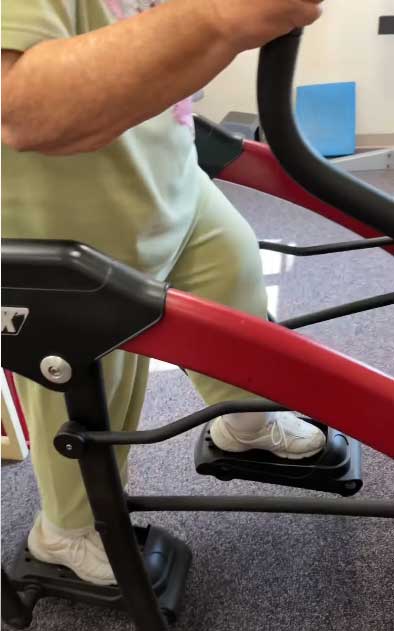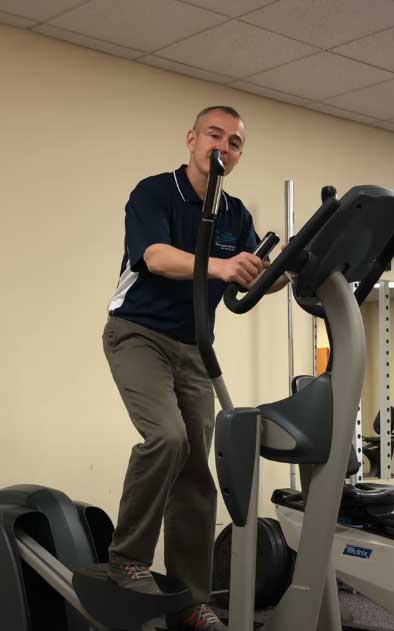2022 Guide to Buying An Elliptical After Total Knee Replacement Surgery
The Schwinn Elliptical 411 is my overall favorite pick for anyone recovering from a total knee replacement in 2022.
What to expect in this article:
Benefits of using an elliptical after total knee replacement
- Less Impact
- Weightbearing
- Rhythmic Motion
- Symmetrical Stride Length
- Increased Muscular Loading
- Decreased Risk of Falling
Less Impact
The American Academy of Orthopedic Surgeons recommend patients reduce high impact activities in an attempt to extend the useful life of their total knee replacement. Running, jumping, and jogging are examples of high impact activities.
Using an elliptical trainer is considered a low or no impact exercise because your feet never break contact with the pedal.
Weightbearing
Standing and walking are examples of weightbearing activities. Our hip, knee, and ankle are joints in the body designed to respond positively to these weightbearing activities.
The National Institute of Health recommends weightbearing exercise to improve bone density and overall health.
An elliptical trainer provides weightbearing, low impact exercise whereas a recumbent bicycle is no impact, but non-weightbearing.
Rhythmic Motion
Walking, clinically referred to as gait, is a rhythmic motion. Normal human gait includes reciprocal arm and leg swings. After a total knee replacement it is common for a patient to favor one side resulting in a limp.
Since the elliptical trainer operates on a track, when one foot moves forward the other foot moves back in a rhythmic motion. Many ellipticals include upper body attachments. This reinforces the motion of a classically normal gait and helps the patient relearn the rhythm of walking.

Symetrical Stride Length
Along with rhythmic walking, the elliptical encourages patients to utilize a symetrical stride length. Since both feet are required to move the same distance in opposite directions patients are unable to take a shortened stride.
The most common compensation after total knee replacement is a shortened stride on the non-surgical leg as an attempt to reduce weightbearing and simple limb support on the surgical leg.
Increased Muscular Loading
Elliptical trainers often have a vertical component to the stepping motion. When a person is walking on a flat surface, the skeletal system is carrying much of the body’s weight.
When a person is walking up hill or on an incline, the leg muscles carry more of the load and as a result burn more calories and require more muscular strength and endurance.
Decreased Risk of Falling
Risk of falling after a total knee replacement is always a threat. One major downfall of a treadmill is the fact that it will keep going regardless of the users involvement. While treadmills do have automatic turn-off switches, users don’t always use them.
An elliptical allows a user to hold on while it also adjusts to the users effort. Since your feet never break contact with the pedals, there is a decreased risk of falling. If the user experiences shortness or breath you may simply stop stepping and the machine will stop moving.
Challenges of using an elliptical after total knee replacement
Two major challenges of using an elliptical trainer after total knee replacement surgery are the muscle strength required to propel the device and the range of motion required in the knee to complete a full revolution.
Muscular Strength and Endurance
Since the elliptical trainer is a full weightbearing exercise and includes a vertical component, many patients are often unable to complete more than 60-seconds of continuous use before needing to stop and rest during their first use.
With time and persistence our patients in the clinic build up their use to a 10-minute duration over the course of 6-weeks.
Knee Range of Motion
Limited knee flexion or extension are common after total knee replacement surgery. Some ellipticals require 90-degrees or more of knee flexion to complete the back-end of the ellipse.
One simple compensation to allow a full revolution is to shift your body forward on the device to reduce the required knee flexion. Then as your range of motion improves you may shift your body back over the pedals.

Recommended features when buying an elliptical
In my physical therapy clinic I often recommend an elliptical trainer for patients who once loved jogging but now want a low or no impact exercise.
When I recommend an elliptical trainer for home use I usually recommend:
- Pedals (foot plates) that stay flat throughout the revolution.
- A device that has the option to use your upper body or not.
- A device with a small floor print
- A device with wheels on the front to allow easy relocation and storage
- A device with large pedals and a comfortable texture on the pedal
My personal recommendation for the BEST moderately priced elliptical trainer in 2022 for home use is:
If you would like to learn more about using an elliptical after a total knee replacement click this link.

Anthony Maritato, PT
Physical Therapist
Anthony Maritato, PT has been a licensed physical therapist and private practice owner since 2006. Ohio license #PT011602.
Anthony has been passionate about helping patients recover from total knee replacement surgery as well as rotator cuff repair surgery.